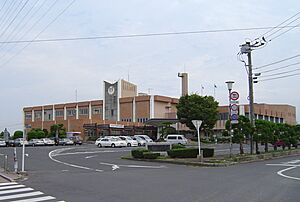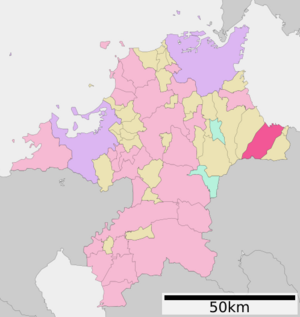Buzen, Fukuoka facts for kids
Quick facts for kids
Buzen
豊前市
|
|||||||||||
|---|---|---|---|---|---|---|---|---|---|---|---|

Buzen City Hall
|
|||||||||||
|
|||||||||||
 |
|||||||||||
| Country | Japan | ||||||||||
| Region | Kyushu | ||||||||||
| Prefecture | Fukuoka | ||||||||||
| Area | |||||||||||
| • Total | 111.10 km2 (42.90 sq mi) | ||||||||||
| Population
(December 31, 2023)
|
|||||||||||
| • Total | 23,844 | ||||||||||
| • Density | 214.617/km2 (555.86/sq mi) | ||||||||||
| Time zone | UTC+09:00 (JST) | ||||||||||
| City hall address | 955 Yoshiki, Buzen, Fukuoka Prefecture, Japan 828-0051 | ||||||||||
|
|||||||||||
Buzen (豊前市, Buzen-shi) is a city located in Fukuoka Prefecture, Japan. It's a place with a mix of mountains and sea. As of late 2023, about 23,844 people lived there in 11,794 homes. The city covers an area of 111.10 square kilometers.
| Top - 0-9 A B C D E F G H I J K L M N O P Q R S T U V W X Y Z |
Exploring Buzen's Location
Buzen is in the eastern part of Fukuoka Prefecture. It's about halfway between the cities of Yukuhashi and Nakatsu.
Mountains and Sea
To the south, you'll find the Chikushi Mountains. This range includes peaks like Mount Kubote and Mount Inugadake. The northern side of Buzen faces the Gulf of Suo. This gulf is part of the beautiful Seto Inland Sea. Most of Buzen is countryside, stretching inland towards mountains. It's about 80 kilometers from Fukuoka, the capital city of the prefecture. It's also 43 kilometers from Kitakyushu.
Nearby Towns and Cities
Buzen shares borders with several other places.
- In Fukuoka Prefecture:
- Chikujō
- Yoshitomi
- Kōge
- In Ōita Prefecture:
- Nakatsu
- Usa
- Hiji
- Kunisaki
Buzen's Weather
Buzen has a humid subtropical climate. This means it has warm summers and cool winters. There's usually light to no snowfall. The average temperature each year is about 15.3 degrees Celsius. Buzen gets about 1623 millimeters of rain annually. September is usually the wettest month. August is the warmest month, averaging around 26.4 degrees Celsius. January is the coldest, with temperatures around 4.3 degrees Celsius.
How Many People Live Here?
The number of people living in Buzen has changed over the years. Here's how the population has looked according to Japanese census data:
| Historical population | ||
|---|---|---|
| Year | Pop. | ±% |
| 1940 | 28,839 | — |
| 1950 | 37,384 | +29.6% |
| 1960 | 34,818 | −6.9% |
| 1970 | 32,049 | −8.0% |
| 1980 | 31,701 | −1.1% |
| 1990 | 31,089 | −1.9% |
| 2000 | 29,133 | −6.3% |
| 2010 | 27,051 | −7.1% |
| 2020 | 25,189 | −6.9% |
A Look Back at Buzen's Past
The area where Buzen is today was once part of an old region called Buzen Province. During the Edo period (a time in Japanese history from 1603 to 1868), most of this land was controlled by the Nakatsu Domain. Some smaller parts were directly managed by the Tokugawa Shogunate, Japan's military government at the time.
After the Meiji restoration in 1868, Japan changed a lot. Modern towns and villages were created. On May 1, 1889, the towns of Hachiya and Ujima were formed. These two towns later merged on April 1, 1935, and kept the name Hachiya.
Then, on April 10, 1955, Hachiya joined with several villages. These villages were Kakuda, Yamada, Mikekado, Kurotsuchi, Senzoku, Yokobu, Aikawa, and Iwaya. Together, they formed the city of Ujima. Just a few days later, on April 14, 1955, Ujima was renamed Buzen.
Buzen's Economy: How People Make a Living
Buzen's economy is mostly rural. This means many people work in farming and fishing.
- Farming: Growing rice is a very important part of the economy.
- Fishing: Commercial fishing, especially for shrimp, is also a big industry.
An industrial area has grown around Ujima Port. Car-related factories have also been built in Buzen. This happened after Daihatsu Auto Body moved into the nearby city of Nakatsu. The Kyushu Electric Power Buzen Thermal Power Plant is also located in the city. This power plant helps provide electricity.
Learning in Buzen: Schools and Education
Buzen has many schools for young people.
- Elementary Schools: There are ten public elementary schools.
- Junior High Schools: The city government runs four public junior high schools.
- High School: There is one public high school. It is managed by the Fukuoka Prefectural Board of Education.
The Buzen Chikujo Medical Association Nursing Advanced Vocational School is also in the city. This school helps train people for careers in nursing.
Getting Around Buzen: Transportation
Train Travel
![]() The JR Kyushu operates the Nippō Main Line through Buzen.
The JR Kyushu operates the Nippō Main Line through Buzen.
- Buzen-Shōe
- Unoshima
- Mikekado
Major Roads
 Higashikyushu Expressway
Higashikyushu Expressway National Route 10
National Route 10
Places to Visit in Buzen
- Ootomi Shrine: This is a local shrine that people can visit.
Famous People from Buzen
Some notable people have come from Buzen:
- Ryōichi Yazu: An inventor.
- Denjirō Ōkōchi: A well-known actor.
- Shigeno Kibe: An early aviator, meaning someone who flew airplanes.
See also
 In Spanish: Buzen (Fukuoka) para niños
In Spanish: Buzen (Fukuoka) para niños






